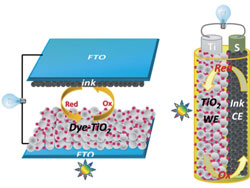Dye sensitised solar cells (DSSCs) have long been recognised as a possible answer to the energy crisis we are facing. Unfortunately, many current solar cells rely on expensive platinum or inflexible carbon based materials in their manufacture. Now, scientists in China have found a cheaper and more efficient alternative in commercial fountain pen ink.
Until now, none of the materials investigated has managed to achieve the light weight, low-cost and biodegradable properties that are attractive in manufacturing flexible electronics. However, Dechun Zou and co-workers at Peking University have found a material that has all these attributes in fountain pen ink.

The idea to use ink in DSSCs came from the concept of ‘paper electronics’, says Zou. Compared to traditional, rigid electronic devices, paper electronics may be the future in achieving the flexibility needed in many commercial applications. An example for the eco-friendly fashion conscious being the application of DSSCs on backpacks and bags for powering portable electronic devices.
Commercial pen ink consists of well-dispersed carbon nanoparticles. Here, the researchers took advantage of the good catalytic activity, high stability and well-established industrial production of the material and directly introduced the ink as a counter electrode material for DSSCs. The ink film was prepared via a spin-coating technique and the layer was shown to be only 3m thick.
Andrew Hamnett, an expert in solar energy and president of the Scottish Marine Institute, UK, comments how the authors have ‘cleverly exploited’ the effort that has gone into optimising carbon suspensions in fountain pen inks and congratulates them on ‘a nice bit of lateral thinking’.
The energy efficiency of the cells is currently at 6.2%, which is comparable to a standard Pt electrochemical device that would be around 1000 times more expensive. Future strategies to increase the catalytic activity may include utilising other film preparation processes or further investigation into the catalytic mechanism of the ink nanoparticles, which Zou says may be ‘challenging but also promising’.
Direct application of commercial fountain pen ink to efficient dye-sensitized solar cells
Xin Cai, Zhibin Lv, Hongwei Wu, Shaocong Hou and Dechun Zou
DOI: 10.1039/C2JM16265B
Read the original Chemistry World article here










